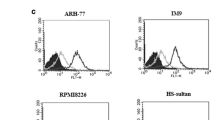Abstract
Recent studies have identified that thyroid hormone receptor-interacting protein 6 (TRIP6) is implicated in tumorigenesis. However, the functional role of TRIP6 in non-Hodgkin’s lymphoma (NHL) has never been elucidated. In this study, we demonstrated that TRIP6 is reversely correlated with the clinical outcomes of NHL patients. Western blot and immunohistochemical analysis revealed that TRIP6 expression is lower in indolent lymphoma than in progressive lymphoma. Kaplan-Meier survival curves indicated that the upregulation of TRIP6 is significantly associated with poor overall survival. Moreover, patients with higher expression of TRIP6 are prone to shorter time to recurrence. Furthermore, we also found that TRIP6 can promote the proliferation of NHL cells via regulating cell cycle progression. In addition, adhesion of lymphoma cells to fibronectin (FN) decreased TRIP6 expression, which led to the upregulation of nuclear p27Kip1 expression by decreasing phosphorylation of p27Kip1 at T157. Importantly, overexpression of TRIP6 can reverse cell adhesion-mediated drug resistance (CAM-DR) phenotype in NHL. In summary, these results suggest that TRIP6 is a novel prognostic indicator for NHL patients and may shed new insights into the important role of TRIP6 in cancer development.





Similar content being viewed by others
References
Li Y, Wang Y, et al. Racial differences in three major NHL subtypes: descriptive epidemiology. Cancer Epidemiol. 2015;39(1):8–13.
Lwin T, Hazlehurst LA, et al. Bone marrow stromal cells prevent apoptosis of lymphoma cells by upregulation of anti-apoptotic proteins associated with activation of NF-kappaB (RelB/p52) in non-Hodgkin’s lymphoma cells. Leukemia. 2007;21(7):1521–31.
Mraz M, Zent CS, et al. Bone marrow stromal cells protect lymphoma B-cells from rituximab-induced apoptosis and targeting integrin alpha-4-beta-1 (VLA-4) with natalizumab can overcome this resistance. Br J Haematol. 2011;155(1):53–64.
Hazlehurst LA, Argilagos RF, et al. Cell adhesion to fibronectin (CAM-DR) influences acquired mitoxantrone resistance in U937 cells. Cancer Res. 2006;66(4):2338–45.
Hazlehurst LA, Damiano JS, et al. Adhesion to fibronectin via beta1 integrins regulates p27kip1 levels and contributes to cell adhesion mediated drug resistance (CAM-DR). Oncogene. 2000;19(38):4319–27.
Fei M, Hang Q, et al. Adhesion to fibronectin induces p27(Kip1) nuclear accumulation through down-regulation of Jab1 and contributes to cell adhesion-mediated drug resistance (CAM-DR) in RPMI 8,226 cells. Mol Cell Biochem. 2014;386(1–2):177–87.
Lin VT. Lin FT TRIP6: an adaptor protein that regulates cell motility, antiapoptotic signaling and transcriptional activity. Cell Signal. 2011;23(11):1691–7.
Lai YJ, Lin VT, et al. The adaptor protein TRIP6 antagonizes Fas-induced apoptosis but promotes its effect on cell migration. Mol Cell Biol. 2010;30(23):5582–96.
Chastre E, Abdessamad M, et al. TRIP6, a novel molecular partner of the MAGI-1 scaffolding molecule, promotes invasiveness. Faseb J. 2009;23(3):916–28.
Lin VT, Lin VY, et al. TRIP6 regulates p27 KIP1 to promote tumorigenesis. Mol Cell Biol. 2013;33(7):1394–409.
Xu J, Lai YJ, et al. TRIP6 enhances lysophosphatidic acid-induced cell migration by interacting with the lysophosphatidic acid 2 receptor. J Biol Chem. 2004;279(11):10459–68.
Gur'ianova OA, Sablina AA, et al. Down-regulation of TRIP6 expression induces actin cytoskeleton rearrangements in human carcinoma cell lines. Mol Biol (Mosk). 2005;39(5):905–9.
Fei J, Li J, et al. Characterization of TRIP6-dependent nasopharyngeal cancer cell migration. Tumour Biol. 2013;34(4):2329–35.
Zhu X, Miao X, et al. ENO1 promotes tumor proliferation and cell adhesion mediated drug resistance (CAM-DR) in non-Hodgkin’s lymphomas. Exp Cell Res. 2015.
Hang Q, Fei M, et al. Expression of Spy1 protein in human non-Hodgkin’s lymphomas is correlated with phosphorylation of p27 Kip1 on Thr187 and cell proliferation. Med Oncol. 2012;29(5):3504–14.
Harada K, Supriatno, et al. Low p27Kip1 expression is associated with poor prognosis in oral squamous cell carcinoma. Anticancer Res. 2002;22(5):2985–9.
Shamma A, Doki Y, et al. Loss of p27(KIP1) expression predicts poor prognosis in patients with esophageal squamous cell carcinoma. Oncology-basel. 2000;58(2):152–8.
Migita T, Oda Y, et al. Low expression of p27(Kip1) is associated with tumor size and poor prognosis in patients with renal cell carcinoma. Cancer. 2002;94(4):973–9.
Seki R, Ohshima K, et al. Prognostic significance of S-phase kinase-associated protein 2 and p27kip1 in patients with diffuse large B-cell lymphoma: effects of rituximab. Ann Oncol. 2010;21(4):833–41.
Chu IM, Hengst L, et al. The Cdk inhibitor p27 in human cancer: prognostic potential and relevance to anticancer therapy. Nat Rev Cancer. 2008;8(4):253–67.
Acknowledgments
This work was supported by grants from the National Natural Science Foundation of China (no. 81201858, no. 81372537) and Natural Scientific Foundation of Jiangsu Province Grant (no. BK2012231).
Conflicts of interest
None
Author information
Authors and Affiliations
Corresponding authors
Additional information
Xiaobing Miao and Xiaohong Xu contributed equally to this work.
Rights and permissions
About this article
Cite this article
Miao, X., Xu, X., Wu, Y. et al. Overexpression of TRIP6 promotes tumor proliferation and reverses cell adhesion-mediated drug resistance (CAM-DR) via regulating nuclear p27Kip1 expression in non-Hodgkin’s lymphoma. Tumor Biol. 37, 1369–1378 (2016). https://doi.org/10.1007/s13277-015-3939-4
Received:
Accepted:
Published:
Issue Date:
DOI: https://doi.org/10.1007/s13277-015-3939-4




